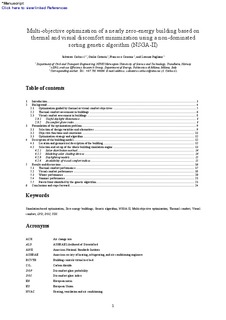| dc.contributor.author | Carlucci, Salvatore | |
| dc.contributor.author | Cattarin, Giulio | |
| dc.contributor.author | Causone, Francesco | |
| dc.contributor.author | Pagliano, Lorenzo | |
| dc.date.accessioned | 2016-07-01T12:15:43Z | |
| dc.date.accessioned | 2016-07-04T08:09:46Z | |
| dc.date.available | 2016-07-01T12:15:43Z | |
| dc.date.available | 2016-07-04T08:09:46Z | |
| dc.date.issued | 2015-07-06 | |
| dc.identifier.citation | Energy and Buildings 2015, 104:378-394 | nb_NO |
| dc.identifier.issn | 0378-7788 | |
| dc.identifier.uri | http://hdl.handle.net/11250/2395392 | |
| dc.description.abstract | Multi-objective optimization methods provide a valid support to buildings’ design. They aim at identifyingthe most promising building variants on the basis of diverse and potentially contrasting needs. However,optimization has been mainly used to optimize the energy performance of buildings, giving secondaryimportance to thermal comfort and usually neglecting visual comfort and the indoor air quality.The present study addresses the design of a detached net zero-energy house located in Southern Italyto minimize thermal and visual discomfort. The optimization problem admits four objective functions(thermal discomfort during winter and summer and visual discomfort due to glare and an inappropriatequantity of daylight) and uses the non-dominated sorting genetic algorithm, implemented in the GenOptoptimization engine through the Java genetic algorithms package, to instruct the EnergyPlus simulationengine.The simulation outcome is a four-dimensional solution set. The building variants of the Pareto frontieradopt diverse and non-intuitive design alternatives. To derive good design practices, two-dimensionalprojections of the solution set were also analyzed. Finally, in cases of complex optimization problemswith many objective functions, optimization techniques are recommended to effectively explore the largenumber of available building variants in a relatively short time and, hence, identify viable non-intuitivesolutions. | nb_NO |
| dc.language.iso | eng | nb_NO |
| dc.publisher | Elsevier | nb_NO |
| dc.title | Multi-objective optimization of a nearly zero-energy building based on thermal and visual discomfort minimization using a non-dominated sorting genetic algorithm (NSGA-II) | nb_NO |
| dc.type | Journal article | nb_NO |
| dc.type | Peer reviewed | nb_NO |
| dc.date.updated | 2016-07-01T12:15:43Z | |
| dc.source.pagenumber | 378–394 | nb_NO |
| dc.source.volume | 104 | nb_NO |
| dc.source.journal | Energy and Buildings | nb_NO |
| dc.identifier.doi | 10.1016/j.enbuild.2015.06.064 | |
| dc.identifier.cristin | 1256773 | |
| dc.description.localcode | This document is the unedited Author's version of a Submitted Work that was subsequently accepted for publication in Energy and Buildings © Elsevier after peer review. To access the final edited and published work see http://dx.doi.org/10.1016/j.enbuild.2015.06.064 | nb_NO |
